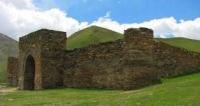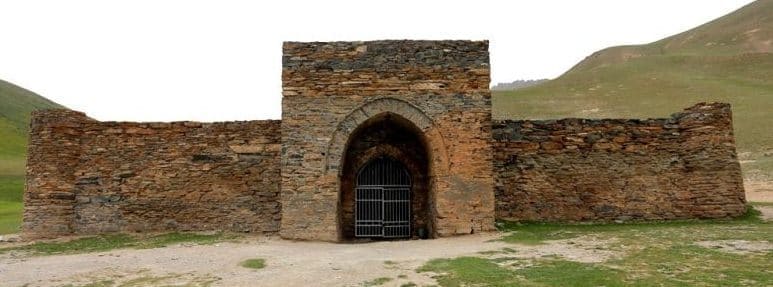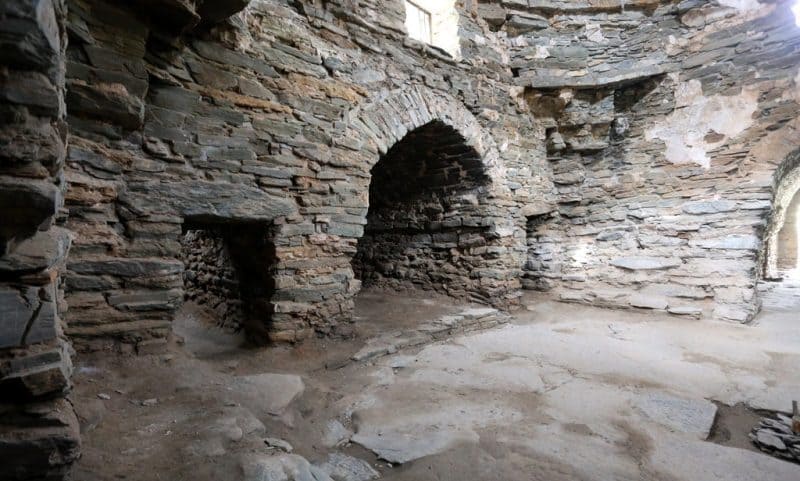You are here
Pantusov about Tash-Rabat.

Legends and traditions of Kyrgyzstan.
“Mohammed Khan built a rabat on the northern side of the Chatyr-Kul gorge. In the construction of this building, he used large stones, similar to those that can only be seen in the imorats of Kashmir. That discount has six doors of twenty gauzes in height. When you enter its gate, to the right - a corridor of about thirty geaz. A dome was made there - twenty geazes high, very beautiful.
Under the overlap of the arch - a passage. On the western edge of it (rabat) a mosque was built about fifteen qaz. There are more than twenty doors on all sides of it. All these buildings are made entirely of stone. And above the gate there are huge blocks of stone, which amazed me very much before I saw the Kashmiri buildings."
«Tarikh-i Rashidi».
Trip in yurts camp in Tash-Rabat.
The detailed description Tash-Rabat is prepared by N. Pantusov who published the report on its inspection in 1901. Pantusov mistakenly took this construction for the temple. However its description is rather full and visually characterizes this construction.
We give this description in that look below as it is submitted at Pantusov.
"The enormous building Tash-Rabat is founded on a contour on the plane which is horizontally extended in a square of 32 meters which, on eminences, departs from a forward facade of the building to back deepening on 3 meters, that is in all height of a back facade owing to what side facades half, in the diagonal of a bottom corner of a forward facade to the top corner back, it is visible on a surface, and all back half of the building, also diagonal is in the earth.
All building is founded on natural soil, on quite wide base. Material of construction consists of not separated plates of mountain blue and red slates, with a laying on the rough cement consisting of a ganch - local alabaster.
All material for a laying of the building was taken in vicinities (not further 200 m from the building) from rocks of the western slope; lime, apparently, was burned out in 2 - 3 kilometers below down the river Tash-Rabat from open rocks of limestone.
The building consists of rectangular rooms in the basis. All these of rooms walls - from a half of their height of the arch the ceilings terminating in square openings in 61 cm which, apparently, served as windows are finished by such material, as well as: in big rooms and corridors on three, and in cells on one such window.
Gleams between the ceiling arches from the outer side of a roof are planned by the earth to the horizontal plane of a roof of all building: this roof the area with a set of window openings was surrounded with an eminence of main external walls from all directions, building roofs on 0,90 m, walls are higher and served as a parapet roof to the area of the building.
Floors in the temple and in some rooms clay, they are covered with smooth tiles of black slate with cement. To see temple floors, it is necessary to make a hole of 1,5 - 2 meters in depth as floors of the temple and all rooms are closed by a part a garbage layer from the fallen arches of ceilings, and a part the manure which collected from time; for the same reason all entrance doors and rooms, and cells from below are encumbered on two thirds of their height.
Before doors and entrances as Kyrgyz speak, were high, it was possible to pass astride, now it is only possible to crawl in them hardly. Internal walls of the building have thickness to 1,40 m and are put on alabaster.
External walls make a square which party of 32 m in the basis. They serve also as a part as walls of the cells adjoining to them, rooms and corridors. Rooms are called which twice and more more extensively than the rooms designated on the plan under figures 5 and 6.
The external facade of the building represents as if a type of an ordinary Asian mazar, without any plaster where the forward facade consists of an arch, entrance from East side, with round columns on two corners block why to an entrance to the building and it is impossible to assume that it is the labyrinth consisting more than of 40 rooms.
As the only entrance to the building serves the double vaulted arch with a ledge both in height, and on foundation of the line of a facade; the arch of a ledge of this arch is destroyed now. After an entrance to an arch the long corridor in the direct direction conducts in arch a doors in khram, having to the right two and on the left three doors conducting in corridors of cells and other rooms; the vaulted ceiling of this corridor is destroyed now.
The entrance arch and two towers on each side it were plastered by alabaster which traces are noticeable also now. These towers are put from the huge stones squared by a semicircle. One of small rooms different from other rooms in size and a look, is nominated here by the temple.
In the basis it has a crosswise appearance; comes to the end with a high dome with windows on the parties. Height of this temple from a floor to top of a dome of 12,80 m. Judging by the remained places of the ceiling beams lying within the walls of the ends it must be assumed that this height was divided into two floors or there were courses, and as entrances to the second floor served four openings which are on vertical continuation of walls and above places of beams; the arches of a dome begin above the mentioned four openings.
These openings or, otherwise, heights, big in 1,22 m, and 0,91 m of width of a window could serve outside and entrance doors as they lie almost on the horizon of the top roofing embankment of the building. On a dome, above these openings on 1,83 m 8 windows in 0:30 sq.m everyone, with gleams equal among themselves lie on its circle nearby.
The building of a dome was outside plastered by alabaster which is well visible also now is already strong that it is impossible to tear off a piece of plaster. In the room of NQ 4 from North side an exit upward, on a roof, with steps is swept up and now; steps for an exit are directed to the East the Big room called the temple has three quite profound vaulted niches (2 on a half) from which two side have no exits, and the niche lying against entrance doors on both sides of it has two doors conducting in side three cells.
To the right and on the left in the temple there are four doors from which the first two at an entrance to the temple conduct through small cells (corridors) through passage to quite big rooms (in the form of the hall lunch or for other meetings) in one of them lying to North side of the building there is the only exit in small without window, a cell; in another, now the half-ruined room lying to the South, does not have exits; the ceiling in it (fallen) was flat of enormous plates.
Other doors conduct from the temple in two small single cells. The cell No. 7 is absolutely dark high room in length of 5 steps, in width 3; the course in it from a corridor was filled up with a stone and to get to it very difficult. On walls of its signs there is no plaster.
Walls are put not especially exactly the Ceiling is covered with two enormous plates: it absolutely equal and not dome-shaped. The described group of rooms of a half of the building, apparently, made the category of the best rooms, as the general entrance to them served the only pass through the temple.
The first half of the building, from an entrance to it to the temple, is divided into two groups of rooms by a big corridor through passage from which the first door to the right conducts in the corridor serving as pass to six cells, and other door - to the long and narrow room which does not have an exit; the first door conducts to two certain rooms, another on the left - in the corridor serving as pass to four cells, the third - also to two certain rooms.
All exit doors both in corridors, and in the cells having height of 1,83 m are littered with garbage now to the fact that for an entrance to them it is necessary to bend down strongly, and it is possible to get into some only on all fours.
An interior of all rooms absolutely naked, is not present any trace of lodgments, niches, etc. In the temple on walls plaster in places remained, but there are no images, except the ordinary bas-reliefs which remained visible representing a number of the niches which are rounded off from above connected by the columns as if supporting the dome basis. In some rooms (cells) on walls plaster in places remained. Finishing (pattern) of plaster of walls in cells, apparently, represented a number of the superficial, from above rounded-off niches what become in the Chinese and houses".



Authority:
The orientalist and local historian N. Pantusov "About Tash-Rabat". 1901.
Photos by
Alexander Petrov.






